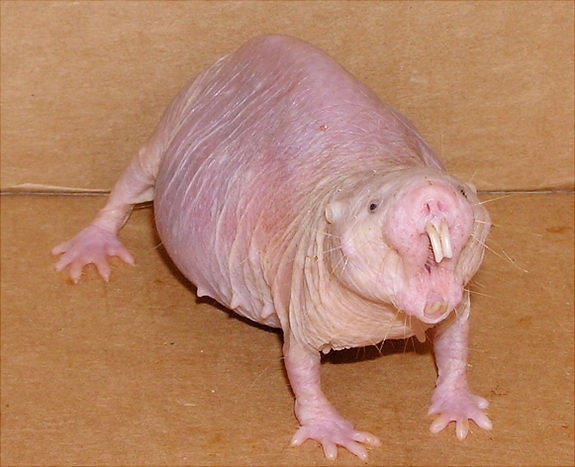If you’ve ever seen a naked mole rat, you may have been gone through a moment of: ‘WTF?’ They’re certainly ugly and strange, little creatures these naked mole rats. But don’t be fooled, these animals are a beautiful gem for scientist around the world.
Scientifically known as Heterocephalus glaber, African naked mole rats are burrowing rats found on the east African coast. These mammals thrive in harsh underground environments; often digging kilometers of tunnels in low-oxygen, high-carbon dioxide areas that would usually suffocate or be very painful for humans. Speaking of pain, naked mole rats literally don’t feel physical pain and this is where scientist find their potential gem.
According to the Cell Report article, (ahem brace yourself) “Hypofunctional TrkA Accounts for the Absence of Pain Sensitization in The African Naked Mole-Rat”, written by a number of scientists but lead by Gary R. Lewin, naked mole rats have numerous of small genetic differences compared to their fellow mammals. Usually when tissues are damaged, the unhappy cells within that tissue will send a signal to the pain-sensing nerves that then are sent to the brain. Interested in these signals, the researchers compared the protein sequence of the naked mole rat’s to 26 other mammal species and five non-naked African mole rat species. When they compared the amino acid sequence of the naked mole rat protein, the researchers discovered three of these protein building blocks (amino acids) were different from other animals. This difference makes the naked mole rat nerve receptor inefficient at relaying the pain sensitization signals. Like a line of dominos that have a piece of wood between them.
Usually this would be a very bad thing, pain is the way the body tells the brain something is wrong and you need to stop messing with the damage area to allow proper healing. But for the naked mole rats, this drop of efficient pain sensors is considered as a good compromise. For proper development of the nervous system, nerve growth and receptors (or the messengers to the brain) are important. This less efficient, albeit still functional receptor still provide naked mole rat with an adequate nervous system, just with less pain nerve cells. With this adaptation, the need for energy to fuel the nervous system is likely reduced for an animal that lives in an environment where starvation is common and the body wants to conserve energy.
So what does this all mean? The naked mole rat could inspire and provide better pain treatments. “Traditional medical interventions for pain have frequently attempted a brute force approach, which can cause unintended bad side effects,” says Thomas Park, a neuroscientist at the University of Illinois, Chicago during an interview with Elizabeth Pennisi, a writer for Science AAAS. Using what has been learned from the mole rat research, neurologist could possibly find a better way to treat pain or at the very least reduce the bad side effects of the treatments.



